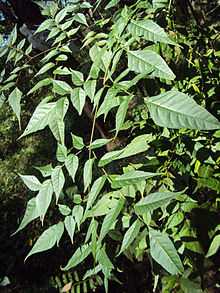Chukrasia velutina
| Chukrasia velutina | |
|---|---|
 | |
| Chukrasia tabularis leaves | |
| Conservation status | |
| Scientific classification | |
| Kingdom: | Plantae |
| (unranked): | Angiosperms |
| (unranked): | Eudicots |
| (unranked): | Rosids |
| Order: | Sapindales |
| Family: | Meliaceae |
| Genus: | Chukrasia |
| Species: | C. velutina |
| Binomial name | |
| Chukrasia velutina M.Roem. | |
| Synonyms | |
| |
Chukrasia velutina (syn: Chukrasia tabularis, Chikrassia tabularis), commonly called bastard cedar, Chittagong wood, Indian mahogany, Burmese almondwood or Jamaica cedar, is a deciduous tree in the family Meliaceae. The species is found in the forests of Chittagong, Chittagong Hill Tracts, Cox's Bazar and Sylhet. The trees are tall with a cylindrical bole and spreading crown. C. velutina leaves are abruptly pinnate or bipinnate with leaflets that alternate or are subopposite, entire and unequal at the base. The erect, oblong flowers, which are rather large and born in terminal panicles, possess four to five petals. Mature fruits are a septifragally three to five valved capsule.
Chukrasia velutina is the provincial flower and tree of Phrae Province, Thailand.[1]
Medicinal value
Chukrasia velutina is used in skeletal fractures,[medical citation needed] while the bark is a powerful astringent used against diarrhoea.[medical citation needed] The seed extract is agglutinating. Leaves of C. velutina contain quercetin and its 3-galactoside, galloyl glucoside, tannic acid and a flavone. The bark contains sitosterol, melianone, scopoletin, 6,7-dimethoxycoumarin, tetranorterpenes and tabularin. Wood contains bussein homologue and chukrasins A, B, C, D & F. Root contains a triterpene cedrelone. Seeds contain tetranorterpenes, phragmalin esters and 12 α-OAc-phyramalin.[2] Four new meliacin esters 3,30-diisobutyrates and 3-isobutyrate-30-propionates of phragmalin and 12-acetoxyphragmalin have also been isolated from seeds.[3]
In some regions the boiled leaves are eaten and used as blood purifier. Extract from young leaves is taken to treat gastritis.[citation needed]
